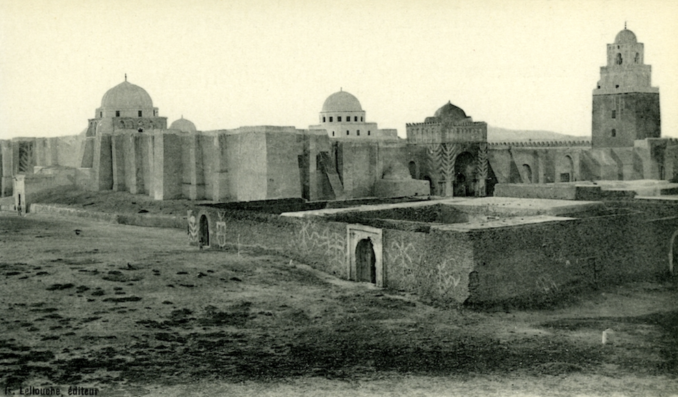“In the fifth of his articles John Alldridge writes of the holy city of Kairouan. It was here that the First Army and the Eighth Army, all the way from El Alamein, finally linked up.” – Manchester Evening News, November 18 1949
Kairouan, Wednesday
Almost exactly one hundred miles south of Tunis lies the holy city of Kairouan.
You reach it by bus which has carried you for the last three hours over an expanse of stony desert. Nothing to break the monotony but an occasional bedouin encampment, a solitary camel pulling morosely at an ancient plough.
Then suddenly the bus crosses a crest. And there before you, its white walls blushing in the early morning sun, lies the fourth holiest city in all Islam.
It is so exactly what you expected that for a moment you think that after all this is only another Hollywood backcloth.
It is all there — the still formidable ramparts enfolding the city like a strong right arm, the white tombs of the faithful — each a mosque in miniature huddled outside the main gate — the lush green of the oasis and, towering above it all and transcending a dozen lesser domes and towers, the tall minaret of the fabulous Grand Mosque, pointing eternally towards Mecca.

Kairouan – Vue generale de la Garnde Mosquee,
Privatbesitz:Orientalist – Public domain
With the exception of Mecca and Medina, Kairouan is probably the most completely Arab city in the world.
Seventy years ago it was still closed to unbelievers. Even today it numbers only 700 Europeans among its dwindling population of 34,000.
It was founded in the year 670 by the all-conquering Sidi Akbar Ben Nafi, Companion of the Prophet, Commander of the Faithful.
Here were mounted those irresistible expeditions that were to carry the fierce flame of Islam as far north as Spain.
Sidi Akbar chose his ground shrewdly. He planted his headquarters mid-way between the mountains and the sea astride two vital caravan routes in the middle of a vast plain that at certain seasons of the year provided him with a natural defensive system of dikes and canals.
Well might he boast:
“I have built a town so strong that it will serve as a bastion of Islam for all time.”
It still provides a problem to any road-bound army which must move north or south.
It was here that the Axis armies chose to fight their last aggressive battle in Africa.
Almost in sight of the ancient Mosque of the Sabres, where fanatical Marabouts once blessed the sacred swords they forged in its very precincts, General Keightley’s Sixth Armoured Division fought it out for the last time with the remnants of Rommel’s 10th and 21st Panzers.
The issue was not long in doubt. In less than an hour British Shermans had knocked out 14 enemy tanks and over 20 of his famous 88mm anti-tank guns.
After that the Axis had had enough. They turned and fled straight through Kairouan to Enfidaville, leaving the empty plain aglow with their burning armour.
That night, April 11, 1943, the First Army had supper in Kairouan, the first town of any size they had captured, while around them, with tears of joy in their eyes, demonstrated the Jews of Kairouan, who had been spitefully abused by the Germans while they occupied the city.
And it was here that the Eighth Army, on the last lap of their victorious 1,500-mile hike up from El Alamein, finally linked up with them.
This was probably a moment as memorable as any in the long war-like story of Kairouan — the lean, sun-blackened gypsies of the Eighth in their ragged shorts and bleached khaki shirts staring curiously at their kinsmen of the First, weighed down by heavy battle-dress and the very latest in lethal equipment, who had struggled over the mountains to meet them.
But today all there is to show of it is the illusion-shattering admonition painted in large lettering right round the eastern wall, “Wear your long pants after sunset.” That and a gaping breach in the same wall, where the Germans helped themselves to the sacred bricks to make an airfield.
And an old clothes market where you may buy the great coat of a panzer grenadier, an R.A.F. flight sergeant’s tunic, or a pair of genuine First Army boots, all with years of good wear still in them.
Otherwise so ageless is life here in this fascinating city in this Arabian Night’s Dream that it might well be a squadron of Sidi Akbar’s janizaries who are garrisoning the ancient fortress of the Casbah and not a bored platoon of French Spahis.
So it is all the more incredible to find yourself sitting cross-legged in a shoemaker’s tiny shop which is straight out of “Chu Chin Chow” and sipping mint tea while the proprietor, who looks like Ali Baba, measures you for a pair of slippers and comments of all things on the “Sunday Times” literary award to Winston Churchill.
Reproduced with permission
© 2024 Newspapers.com
Jerry F 2024



